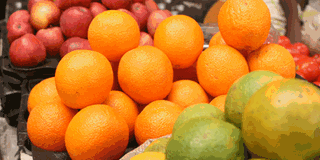Prime
Fruit production opportunity still underexploited

Fruits at Nakasero market. Uganda has a higher potential to supply fresh fruits to other countries. Photo by Faiswal Kasirye.
What you need to know:
Statistics from Uganda Export Promotion Board (UEPB) show that in 2011, Uganda exported 1,442 tonnes worth $3.6 million, showing an increase from the previous year’s 721 tonnes worth $2.1 million.
Before the crack of dawn, Ms Rukia Kirabo, a resident of Lukalu-Village in Luwero district together with her three sons collect and pile baskets of mangoes and pineapples.
They then carry baskets and place them at the roadside with the hope of finding middlemen who move from one village to another in search for these fruits.
This is the path that Ms Kirabo has taken to earn some extra money especially when the fruits are in season.
“I have over 20 mango trees and two acres of pineapples from which I collect at least half a tonne of mangoes when in season and about 200 pineapples,” Ms Kirabo explains.
But sometimes the middlemen don’t turn up and all the fruits rot.
Regardless of the tonnes of fruit varieties Uganda is producing, investors say they are not fit for processing according Uganda Investment Authority (UIA).
UIA is trying to market the industry but its efforts are hitting a snag.
“Many investors have shown interest in investing in fruit processing but they have found the available species not fit for processing,” Ms Sheila Mugyenzi Karungi, the UIA spokesperson told Prosper magazine.
Uganda is gifted with a good climate favouring the different varieties of fruits grown organically.
This has positioned the country as one of Africa’s leading fruit producers.
Uganda boosts of a variety of tropical fruits which include pineapples, oranges, passion fruits, mangoes, paw paws, tangerines, jack fruits, avocados, lemons, apple bananas, guavas, lemons, apples, berries and tomatoes.
Uganda’s fruit industry is not as developed as that of Kenya and South Africa where commercialised fruit production has taken off. Instead, most fruit production is done on a small-holder level in a subsistence form.
With little revenue earned from exporting fresh fruits against all the stringent regulations, not much has been realised.
Statistics from the Uganda Export Promotion Board (UEPB) show that in 2011, Uganda exported 1,442 tonnes worth $3.6 million, showing an increase from the previous year’s 721 tonnes worth $2.1 million. The biggest market is now within the East African region, particularly Kenya, South Sudan and Rwanda. And outside the region the European Union remains the biggest consumer.
Experts say if the rest of the fruits which are not locally consumed or exported fresh are processed, many farmers’ livelihoods along the value chain would improve. Despite this great production potential, fruit processing is low and limited to extraction of juice, drying, bottling and labeling.
The problem
Ms Karungi says the biggest challenge is that investors demand for specific strains of fruit varieties that can be used for processing.
“Companies which have processing are instead using concentrates imported and some are extracted from fruits exported out of Uganda then brought back as concentrates, yet these fruits can be sourced locally,” Ms Karungi said.
South Africa and Kenya are the main suppliers of concentrates to Uganda, denying Uganda an opportunity to supply the market with fresh fruits.
She said: “The whole task goes back to NARO-Kawanda to work hand in hand with the processors to produce the specific species required so that they are distributed to the farmers for production.”
Ms Karungi argues that government through the agriculture ministry should zone the suitable areas that favour fruit production in addition to developing the necessary infrastructure.
Apparently, there are no statistics to justify how many quantities of fruits Uganda produces according to information from the Department of Crop production in the ministry of Agriculture.
“We have so many varieties of fruit but the quality and quantities are still wanting,” Dr James Tumwine, the senior officer in the department of crop production said.
Commenting on research, the head of Biotechnology centre at NARO-Kawanda, Dr Andrew Kiggundu said Kawanda has not yet developed varieties specifically for fruit processing.
He however said the fruits in the country can be used to make concentrates.
Dr Sophia Musana, NARO’s head of horticultural research said they have come up with the required breeds but due to external influence they are not used.
She said a variety commonly known as Capule (Pervin) has always been grown in Pallisa.
He however said since investors want NARO to do research on the specific varieties they want, they should consider that the trees which would take two to three years to start producing fruits.
“We have to identify which places the different varieties developed can grow best before they are distributed to the farmer,” Dr Kiggundu added.
Recommendations
He advises NARO-Kawanda to partner with the private sector in these approaches:
Primarily, to carry out research on machinery, which can later be modified to suit fruit processing.
The other alternative is to import the varieties they (processors) think are best for processing so that they can be introduced to the farmers in different areas of Uganda.
In the 1960s, commercial fruit production for domestic consumption and export was successfully undertaken. Government run schemes were established at Kiige (Kamuli district), Ongino (Kumi district), Odino (900 hectares in Soroti district) and Labori (800 hectares in Soroti district).
These schemes produced various citrus fruits that supplied Kenya, Rwanda and Burundi. Production on these schemes went on until the mid-1970s when the political climate then made it hard to continue with meaningful management.
Initially, the schemes were developed to use irrigation such that there is all-year-round production.
“These schemes have massive and extremely productive land which is still under government control and could be available for reviving commercial fruit production,” UIA says.
UIA says there is still room for investments in the fruit processing sector. There are only four major companies involved in fresh fruit juice processing.
Processors
Although processing is still low and is mainly limited to extraction of juice, drying, bottling and labeling.
House of Dawda is one of those investors who have ventured into processing of the local mangoes commonly known as Sena – (Land race) fibrous mangoes into Splash mango juice.
The company procures 500 tonnes of mangoes, 800 tonnes of pineapples and 150 tonnes of tomatoes with a steady supply annually.
According to the company’s Chief Executive Officer (CEO) Mr Vinay Dawda, they have rolled out a campaign to boost passion fruit production. The company has so far given out 20,000 seedlings to the farmers who will in turn grow and later supply for production purposes.
Century Bottling company - Coca Cola producers has been supporting farmers in Pallisa to produce mangoes used in processing Minute Maid- a new fruit juice they have added on their list of products.
The large quantity of mangoes in Soroti region - eastern Uganda - provided the Bill and Melinda Gates Foundation and Coca-Cola the basis of improving the livelihoods of local farmers.
In 2010, two organisations and TechnoServe - an international non-profit organisation, announced a four-year $11.5 million partnership to support farmers in Uganda and Kenya to grow more mangoes and passion fruits.
According to this agreement, Coca Cola was meant to buy pulped fruit from the fruit farmers for making its juices.
However, two years into the project, Coca Cola is looking to declare the project’s progress before the end of this month, Ms Maureen Kyomuhendo, the company’s Public Relations manager said.
The Coca Cola Project is benefiting farmers in both Kenya and Uganda. About 54,000 farmers will benefit by the end of 2013, of which 17,000 farmers are drawn from Uganda.
“No specific target in output is envisaged, but if we can obtain all our raw materials for making passion and mango fruit from local farmers, then that would be the target,” Mr Bob Okello from Coca Cola said.
Before Coca Cola unveils the progress, NARO’s head of Horticultural Research, Dr Sophia Musana alleges that the Cola Cola project was to benefit more Ugandans but because of misinformation about Uganda’s passion fruit breeds, the bigger share was given out to Kenya.
“Coca Cola employed a researcher from Kenya who told Kenyan passion fruit traders in Owino that the passion fruits produced in Uganda, especially the hybrid from Kawanda, is not good for processing. So, most of the money went to Kenya,” Dr Musana said.
“When investors allege that the local breeds like Sena (Kagogwa) are not fit for processing, it beats my understanding because Britannia Allied Industries has been using it to process Splash juice,” Dr Musana said.
She said Coca Cola is now buying the yellow passion fruits from Kenya which have a higher acidity, yet the Ugandan hybrid is less acidic.
Government efforts
Two irrigation projects are now being implemented. Under the farm income enhancement and forest conservation (FIEFOC) project, the government has secured loan funds to rehabilitate four old schemes (Mobuku, Doho, Agoro and Olweny) and under the water for agricultural production projects, four other schemes will be rehabilitated (Kiige, Odina, Labori and Atera).
Government is also yet to set up a citrus fruit processing factory in Teso region in Soroti District.




